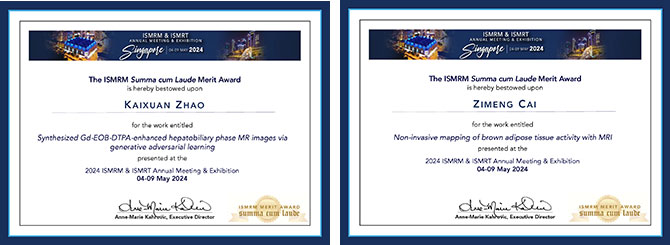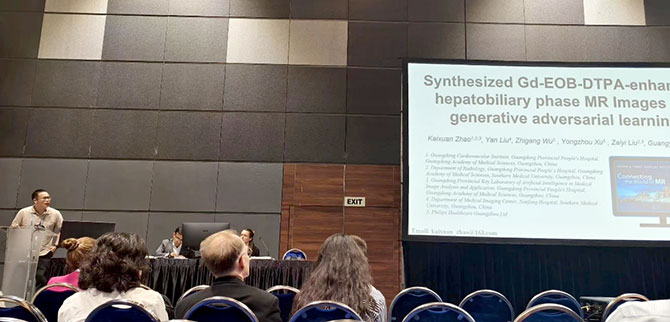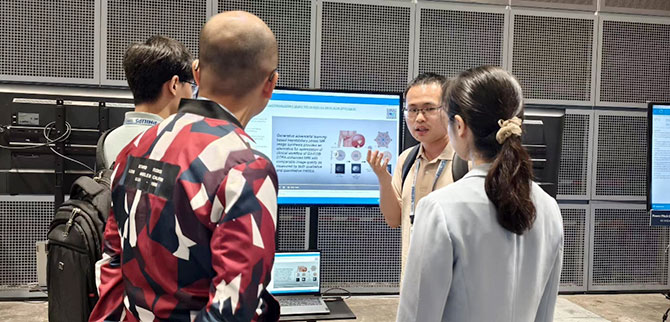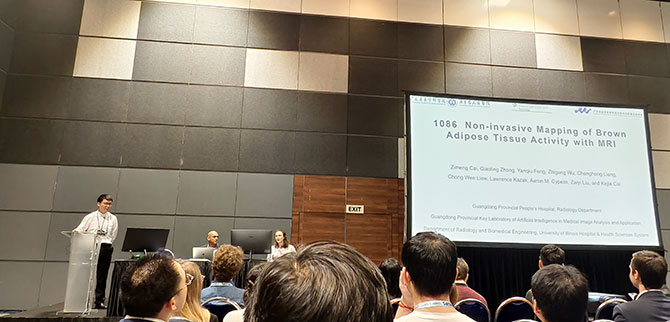

The 32nd ISMRM & ISMRT Annual Meeting & Exhibition kicked off in Singapore in May 2024. Dr. Zhao Kaixuan and Dr. Cai Zimeng from the Department of Radiology were awarded the Gold Award (Summa Cum Laude Merit Award) for their research findings at this year’s conference. It is reported that out of 5,194 submitted conference papers this year, only the top 3% of outstanding papers received the Gold Award.

Founded in 1994, the ISMRM is committed to advancing the application and development of magnetic resonance imaging (MRI) technology in medical diagnosis, treatment, and research. The ISMRM Annual Meeting is one of the most influential conferences in the field of magnetic resonance and an international scientific event, bringing together researchers and medical experts from around the world to discuss the latest and cutting-edge advancements in medical science and technology.
Dr. Zhao Kaixuan delivered an academic presentation titled “Synthesized Gd-EOB-DTPA-enhanced hepatobiliary phase MR images via generative adversarial learning,” which focuses on the application of next-generation artificial intelligence technology in clinical assistance. The research leveraged generative adversarial networks (GANs) to achieve early prediction of Gd-EOB-DTPA enhancement, a technique that holds promise for significantly reducing clinical scanning time and improving scanning efficiency. This research was awarded the Gold Award at the ISMRM 2024 and sparked lively discussions at the event.


Dr. Zhao Kaixuan presenting and engaging in discussions on-site
Dr. Cai Zimeng’s research, titled “Non-invasive mapping of brown adipose tissue activity with MRI,” was also awarded the Gold Award at the ISMRM 2024 and received enthusiastic responses during his oral presentation at the event. The study established creatine-based chemical exchange saturation transfer MRI (CrCEST MRI) as a promising non-invasive and radiation-free method for imaging brown adipose tissue activity. The endogenous CrCEST MRI technique provides molecular insights into the mechanisms of metabolic diseases through longitudinal and non-invasive means, aiding in early detection and risk stratification. Additionally, it serves as a biomarker for the development, evaluation, and guidance of new therapeutic strategies.


Guangdong Provincial Key Laboratory for Intelligent Analysis and Application of Medical Imaging, affiliated with Guangdong Provincial People’s Hospital, collaborates with South China University of Technology and the Shenzhen Institute of Advanced Technology, Chinese Academy of Sciences for top-tier academic resources. The laboratory focuses on the strategic needs of the Guangdong-Hong Kong-Macao Greater Bay Area and the “Healthy China 2030” initiative. Aiming to “build a first-class platform, nurture first-class talents, conduct first-class research, and produce first-class outcomes,” the laboratory is dedicated to the development and transformation of cutting-edge technologies in intelligent medical imaging analysis. It seeks to achieve collaborative innovation across industry, academia, research, and application, pioneering interdisciplinary research in the field of medical imaging artificial intelligence and exploring new models for cultivating interdisciplinary talents at the intersection of medicine and engineering. The Department of Radiology, to which the laboratory belongs, is recognized as a national clinical key specialty. The research team is highly accomplished, with Prof. Liu Zaiyi, a recipient of the National Science Fund for Distinguished Young Scholars, serving as the chief and academic leader. Prof. Lu Cheng, a recipient of the National Science Fund for Excellent Young Scholars (Overseas), and Prof. Liang Huiying, a recipient of the National Science Fund for Excellent Young Scholars, serve as the deputy chief. The team is currently working on 78 national and provincial-level research projects, including the National Key Research and Development Program and the National Science Fund for Distinguished Young Scholars, the National Science Fund for Excellent Young Scholars, and the Guangdong Provincial Key Areas Research and Development Program. In recent years, the team has published a series of academic papers in top international journals, such as J Clin Oncol, Circulation, Ann Oncol, Lancet Digital Health, Clin Cancer Res, and Nat Biotechnol. Dr. Zhao Kaixuan is a postdoctoral researcher at Guangdong Provincial Key Laboratory for Intelligent Analysis and Application of Medical Imaging, working under the supervision of Prof. Liu Zaiyi. His main research focus is on the intersection of MRI technology and artificial intelligence. He has published four SCI papers as the first author (including co-authorship). Dr. Cai Zimeng is a doctoral student (2021) at the School of Medicine, South China University of Technology, also under the supervision of Prof. Liu Zaiyi. His primary research focuses on new methods for magnetic resonance fat imaging technology and its clinical applications. He has published two SCI papers as the first author (including co-authorship).
The research achievements of two PhD researchers from the Department of Radiology have been awarded the prestigious Gold Award at this year’s ISMRM, marking not only a significant breakthrough in the field of medical MRI but also a testament to the effectiveness of the department’s strategic planning and talent cultivation. The Chinese saying “a hundred flowers blooming makes a spring” aptly captures the spirit of this success. The Department of Radiology of Guangdong Provincial People’s Hospital will continue to delve deeply into academic research and innovation, further strengthening international collaboration and exchange, nurturing more outstanding young talents, and relentlessly driving forward breakthroughs and technological advancements in the field of medical MRI.
Cen Chunyuan
Updated: June 25, 2024